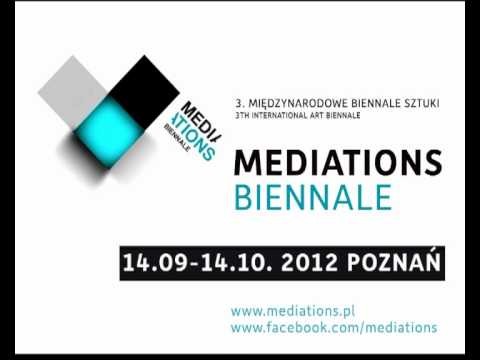MEDIATIONS BIENNALE 2012
14 Sep - 14 Oct 2012
The Unknown - Niepojmowalne
14 September – 14 October 2012
Curators: Denise Carvalho, Friedhelm Mennekes, Fumio Nanjo, Tomasz Wendland
Co-curators: Drorit Gur Arie and Rita Varga
Adel Abdessemed, Orit Adar Bechar, Nicole Ahland, Makoto Aida, Istvan Balogh, Stephan Baumkötter, Ulrich Behr, Mane Hellenthal, Benjamin Bergmann, Xu Bing, Thomas Björk, Richard Bond, Paulo Bruscky, Olaf Brzeski, Nick Cave, Stephen Cornford, Attila Csörgő, Joseph Dadoune, Stanisław Dróżdż, Wojciech Duda, Richard Fajnor, Andrzej Fasiecki, Monika Fioreschy, Andrea Galvani, Gabriela Golder, Jens Haaning, Nol Hennissen, Joanna Hoffmann-Dietrich, Nick Hornby, Ali Hossaini, Bernd Jansen, Magdalena Jetelová, Timo Kahlen, Adam Kalinowski, Tadeusz Kantor, Grzegorz Klaman, Leszek Knaflewski, Dariusz Kowalski, Jarosław Kozłowski, Corinna Krebber, Oliver Kruse, Mischa Kuball, Takashi Kuribayashi, Piotr Kurka, Julie Laignel, Wojciech Leder, Young-Jae Lee, Sang Nam Lee, Simon Lee, Petra Lemmerz, Daniel Lergon, Kristin Lucas, Cristina Lucas, Wojciech Łazarczyk, Tea Mäkipää, Lenore Malen, Teresa Margolles, Shahar Markus, Alice Miceli, Tatsuo Miyajima, Aiko Miyanaga, Simon Morley, Oscar Muños, Suzanne C. Nagy, Ilona Németh, Charly Nijensohn, Morio Nishimura , Glexis Novoa, Motohiko Odani, Julia Oldham, Maciej Olszewski, Robert and Shana Parkeharrison, Fernando Prats, Nicolas Provost, Araya Rasdjarmrearnsook , Ki-Bong Rhee, Timothy RODA, Maciej Rudzin, Robert Rumas, Mithu Sen, Sean Shanahan, Regina Silveira, Ran Slavin, Alexander Steig, Attila Szűcs, Zbigniew Taszycki, Gerhard Trieb, Kin-Wah Tsang, Adriana Varella, Heather Dewey-Hagborg, Alejandro Vidal, Alex Villar, Bill Viola, Quingsong Wang, Witkacy, Alvin P. Zafra
The unknown exists with the same intensity as the known or everything already comprehended. Perhaps a better way of putting it is: what exists, exists; what does not exist, exists as well.
Dagmar Reichelt – in Neue Zuricher Zeitung in 2010 – wrote that a creative process is simultaneously a research process which results in a stream of reflection, not only in a verbal form, but most of all in a mental one. Artists seem to be participants in the process of knowledge creation while being also, in a similar way to a viewer, creators of their own interpretation of an image.
If time was conceptualised as a playground, it would be possible to talk about available simultaneity bound only by an ability to comprehend one own's act of participation. Life would lend itself to be seen as a series of limited acts of participation, which outcome would lead us to the natural rejection of some unwanted, faultless possibilities. Awareness suffers from deficiencies and unexpected surpluses which occur as result of the accumulation of experience. On the other hand, the state of unawareness is as equally strong an act of participating as that of awareness.
David Bohm writes that 'The entire world of material things is a fragment of the whole. Everything is connected to everything else, every part of the whole contains the whole.' Reality defined in such a way may remain unknown. A result of it is a participation in the whole. Nothing is complete in itself and it may fulfil itself only through participation. There exists, therefore, a suggestion that values such as life and mind may develop in the whole. We need to become aware of the fact that we are a part of a such reality and 'we do not think about it but we think it'. What is understandable becomes a tool for comprehending everything that remains unknown and vice versa. If I were to teach, then I would certainly teach something I do not know.
In 1954, Joseph Beuys said that a cross and Christ as symbols were exhausted. He further ascertained that speaking about spirituality is more profound without those representations. The new ways of thinking about Spirituality was initiated by Wassily Kandinsky's book entitled Point and Line to Plane – it concerned a search for new iconography of spiritual language in art. I am under the impression that people, since then, have been under some repression. They have been subjected to the control of past symbols, images; later on, objects and gestures, and finally landscape, colour, light and geometrical forms. After Kandinsky and Duchamp, an experience of spirituality in contact with art has taken the form of an individual contact, both in the case of an artist and a viewer. Cultural locality, collective values, systems and religions do not determine the search for one's own pathway. They no longer determine answers to a question about the individual experiencing of spirituality.
The fact that I do not understand something does not bother me. I create my own cloud of unawareness. It becomes nicer and fuller, richer and more versatile. It becomes something I know exists. I become accustomed to what it is like. Being immersed in unawareness, I navigate my way across it while having an ability to tell the difference between it and the state of knowing. Knowledge turns out to be flat and exhaustible. It limits my own thinking about it by appointing ways of thinking and perceiving without a chance to change my stance towards all that surrounds me. Definitions are sharp and equivocal. They subjugate designates to one and only function. To recall John Cage's word, there comes this moment when we become aware that there are no wrong answers, because all of them are correct. We experience the fact that what is significant is hidden behind an artwork's readable surface and it remains inaccessible. This inaccessibility appears to be a new dimension present in reality. Sometimes, we manage to disclose a gap, a rupture in the sphere of belief and consciousness surrounding us, through which we manage to discover a different dimension, new proportions. It does not matter that we do not understand what we see, since it is the context that matters. From Kandinsky's times, new iconography has been being shaped in art spirituality. Spirituality based on individual experiences and emotions. Iconography of the unknown is, among other issues, the topic of the third edition of Mediations Biennale.
Tomasz Wendland
The director of 2012 Mediations Biennale

